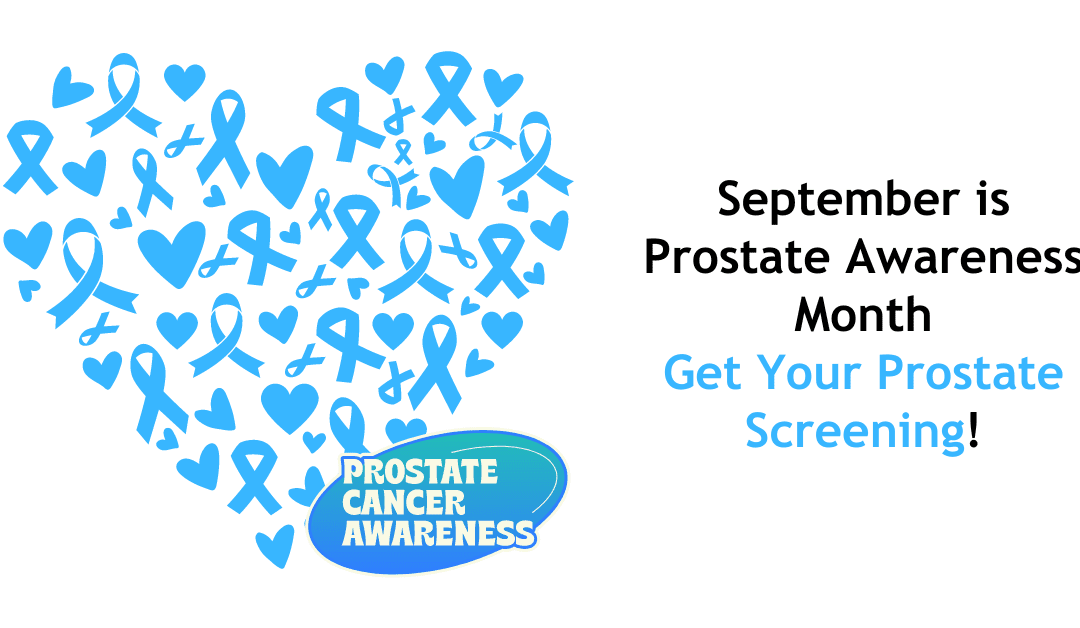
by Bag It Team | Sep 12, 2023 | Educational Articles
Did you know…
Prostate cancer is the most common type of cancer (excluding skin cancer) among men? About 1 in 8 men will receive a prostate cancer diagnosis during their lifetime, with higher rates among Black and African American men.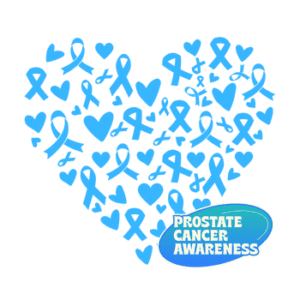
Like most cancers, usually the earlier prostate cancer is caught, the better the chances of staying disease-free. Screenings are important because you may not have any symptoms.
When to start prostate cancer screening is a personal decision that should be made after talking with your doctor. They will assess factors such as your age, race, medical and family history, additional risk factors and any symptoms you may be experiencing. Together, you’ll discuss the pros and cons of screening.
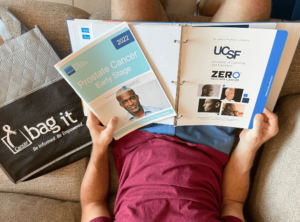 The good news is that the vast majority of prostate cancers are found just within the prostate (local) or the region near it (regional), when active surveillance or immediate treatment has a very high success rate.
The good news is that the vast majority of prostate cancers are found just within the prostate (local) or the region near it (regional), when active surveillance or immediate treatment has a very high success rate.
Developed for men with early-stage prostate cancer, we launched a new Prostate Cancer Bag It Bag to arm you and your partner with helpful tools and reliable information to make decisions and self-advocate during your prostate cancer journey.
Order Your Prostate Cancer Bag

by Bag It Team | Feb 2, 2023 | What's New
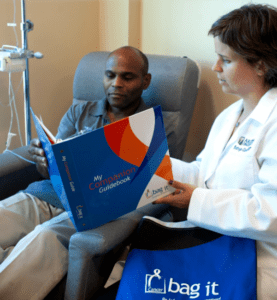 KGUN 9 News Anchor and Reporter Pat Parris Interviews colon cancer survivor Ingrid Jacobs and Bag It Cancer’s Executive Director Mindy Griffith about the impact the resources in the Bag It Bag have had on cancer patients. Every month KGUN 9 features a local nonprofit for our Giving Project and Bag It is their charity for the month of February, 2023.
KGUN 9 News Anchor and Reporter Pat Parris Interviews colon cancer survivor Ingrid Jacobs and Bag It Cancer’s Executive Director Mindy Griffith about the impact the resources in the Bag It Bag have had on cancer patients. Every month KGUN 9 features a local nonprofit for our Giving Project and Bag It is their charity for the month of February, 2023.
We invite you to make a donation to Bag It at KGUN 9’s Giving Project page. Their partners in the Giving Project, the Community Foundation for Southern Arizona, will match the first $500 in donations.
Watch and read this wonderful story about our organization.

by Bag It Team | Nov 8, 2022 | Educational Articles
For many people, having a trusted friend or family member join them during a doctor’s visit or test (in person, virtually, or by phone) can be a great source of comfort and practical help. Sitting in may also bring you some peace of mind.
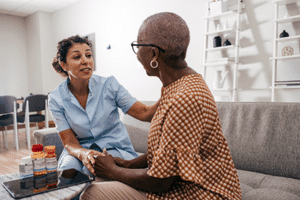
Besides being there for support and a second set of eyes and ears, you may also be that person’s advocate—gathering and sharing information with the healthcare provider, collecting information for them, and following up after the appointment to ensure continuity of their care. Knowing what to do before, during, and after a medical appointment can help safeguard the health and well-being of your loved one.
The Bag It Cancer’s Bag contains a nifty take-everywhere binder that was designed to help people get prepared for their medical appointments, keep track of information and records in an organized manner, and accompany them to each visit. Here are some of the tips from the binder.
Prepare for the appointment
- Set time aside with your family member or friend to discuss the primary purpose of the appointment. Is this a check-up? Follow up visit? Possible new medical condition? Together make a written list of questions, notes, or updates to share with the provider, keeping it to a single page and leaving room for the answers). This might include new symptoms, possible side effects of medications, or a new medical condition since the last visit. Also, discuss how they would like you to assist them during the appointment so you come to an agreement about your role.
- Star the three top priorities on your list to discuss in case you don’t get to all of them. Some people prefer to make an extra copy to hand directly to the doctor at the start of the visit.
- Gather everything needed for the appointment. Use Bag It’s My Companion Guidebook to store and record all your information in the tabbed sections and on the helpful patient forms. You will need:
- Day/date/time of the appointment. (Note that providers often ask you to arrive earlier to complete paperwork.)
- Name, address, phone number of the provider’s office.
- Driving directions if needed. If someone is attending virtually or by phone, make sure you have the log in or call-in details in advance.
- Insurance cards and copays due at the time of service.
- Copies of your medical records, including medical and family history.
- A notebook, pen or a recording device such as a smart phone with recording app.
- A complete and accurate list of current medications, vitamins/supplements, and over the counter medicines being taken.
- If lab work, tests, imaging, or other procedure needs to be completed so the doctor can review the results at your appointment, schedule them in advance and with enough time for the report to be available to the provider. Call to make sure the results have been received by the doctor’s office. Or pick up a copy of the results and bring it with you to your appointment, if needed.
- If communication with the provider will be difficult for the patient due to a language barrier, request that a professional interpreter be present during the appointment. Relying on a family member or friend to perform this role is not the best choice when complicated medical terms may be used to discuss the patient’s diagnosis and treatment options, or difficult treatment decisions may need to be made.
- If you decide to go online to research the patient’s disease or condition, avoid misinformation by visiting only reliable medical websites. Download our tips on how to evaluate medical websites. Always discuss with the provider any information you find online to make sure it is appropriate for your loved one and their situation.
The information and forms are just what is needed to assist with recording your cancer journey. The guidebook gives information to help explain and understand what to expect and record for the future. The bag helps you feel more comfortable speaking up for yourself by providing forms to write down questions and concerns which will help to explain at future doctor appointments.
–Caregiver, California
During the appointment
- Introduce yourself to the provider if you have not met them and explain your role and who you are to the patient. If you will be attending appointments on a regular basis, begin to build your relationship as a member of the patient’s care team.
- If your loved one is unable or hesitant to actively communicate with their provider, speak up on their behalf early in the conversation if this is what was agreed to by you and the patient.
- Verify the doctor has received the results of testing or procedures completed since the last visit. Provide a copy of the results if they have not been received.
- Address the priority concerns and questions on your list. Be direct, honest and respectfully assertive when speaking with the provider.
- Listen carefully. Take notes and write the down the answers to the questions asked. Another idea is to record the conversation, with the provider’s permission. There are apps to download onto a smartphone, or use another recording device.
- Before the visit concludes, make sure any information relayed to you is well understood, including how to perform any medical tasks required at home. If not, ask for it to be explained again in a different way or using everyday language. Ask follow-up questions as needed. Repeating or rephrasing the important parts back to the provider are good ways to confirm you interpreted the information correctly.
- You can also ask for information to be provided to you in writing so you can refer to it at home. This is especially helpful for instructions on how to perform home care tasks.
- Review the patient’s current medications. Understand why any new medications are being prescribed, and make sure you are clear on how, how much and when the medicine should be taken to avoid medication errors.
- Find out the best way to communicate if a non-urgent matter arises between visits. Some offices prefer a message sent through the portal, some use email, and some will ask you to call a specific member of the health care team. If your loved one agrees, consider giving the provider your phone number and/or email as another point of contact.
- If there wasn’t enough time to address all the questions and concerns with the doctor, ask if a nurse or other member of the healthcare team can help you further that day, or follow up with you after the visit. You can also ask to make another appointment to continue the conversation.
- Request copies of any test results, reports or other medical records related to the appointment if not given to you automatically. If they are available online through the patient portal, confirm you have the correct URL for the website and instructions on how to set up a user name and password.
- Before leaving the office make any follow up appointments needed, if possible. Be sure any orders for lab work or other testing or procedures are given to you or sent electronically to the medical facility. This also includes any referrals to other providers.
After the Appointment
- Recap the visit with your loved one. Finish writing any notes or instructions you didn’t jot down in the office. Listening to the recording of the visit would be helpful here.
- Update the patient’s file with any new reports, test results or other documents you received during the visit. Download and print a copy to file if they are online in the patient portal.
- Fill all prescriptions promptly. Verify the pharmacy has a complete and accurate list of all the patient’s medications to avoid drug interactions. Report to the doctor any new symptoms or side effects that could be related to new medicines the patient is taking.
- If any lab work, tests or procedures, or referrals to other doctors were ordered during the visit, schedule these appointments in a timely manner. Ask when and how you will receive the results. Be sure to follow up with the office if you do not receive the results within the expected time frame –do not assume “no news is good news.” If you do not understand the results, reach out to the provider’s office for an explanation of what they mean.
We hope that these tips guide both you and your loved one to better health and more peace of mind.

by Bag It Team | Oct 27, 2022 | What's New
 In this article by Loni Nannini to the Arizona Daily Star, we learn how the Bag It Bag has helped 90,000+ cancer patients and how it will be showcased at the Bag It for Cancer Breakfast at 7:30 a.m. on Thursday, November 17, at the Community Foundation for Southern Arizona Campus, 5049 E. Broadway. Read the Article. OR Learn More About the Breakfast.
In this article by Loni Nannini to the Arizona Daily Star, we learn how the Bag It Bag has helped 90,000+ cancer patients and how it will be showcased at the Bag It for Cancer Breakfast at 7:30 a.m. on Thursday, November 17, at the Community Foundation for Southern Arizona Campus, 5049 E. Broadway. Read the Article. OR Learn More About the Breakfast.
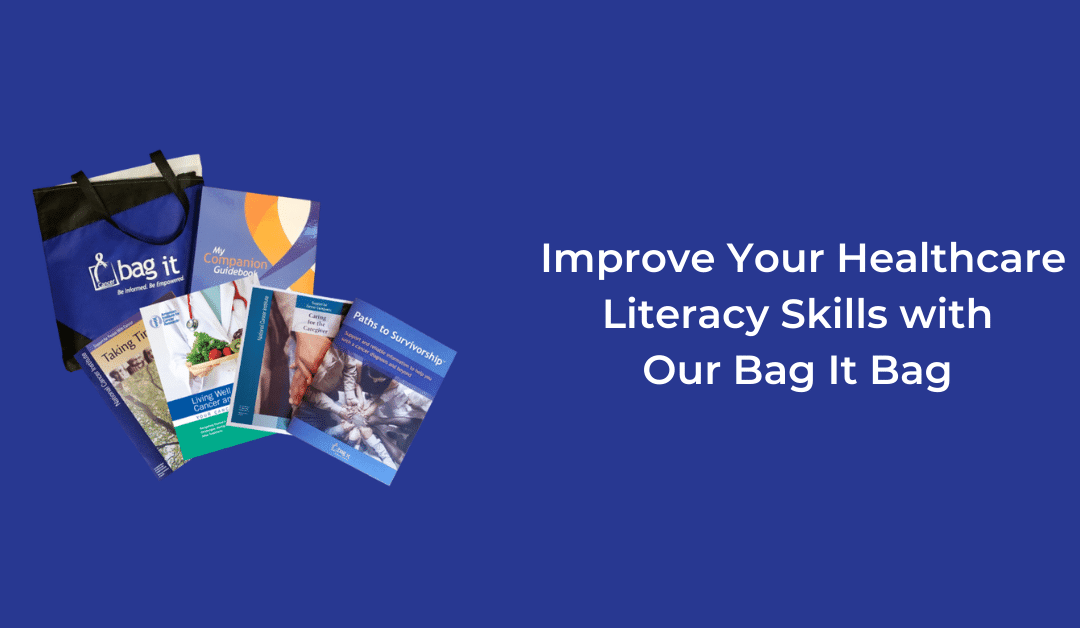
by Bag It Team | Oct 10, 2022 | Educational Articles
 October is Health Literacy Month. A study by Health & Human Services Office of the Surgeon General showed that only about 12% of Americans have proficient health literacy skills. Unfortunately, many adults lack good knowledge about their medical condition and treatment, and don’t know how to get information that is presented in a way they can understand. People report having difficulty completing medical forms and relaying important details to their doctor about their health. They may not be able to accurately read directions to take their medicines as prescribed. Each of these common situations can be linked to poor health outcomes.
October is Health Literacy Month. A study by Health & Human Services Office of the Surgeon General showed that only about 12% of Americans have proficient health literacy skills. Unfortunately, many adults lack good knowledge about their medical condition and treatment, and don’t know how to get information that is presented in a way they can understand. People report having difficulty completing medical forms and relaying important details to their doctor about their health. They may not be able to accurately read directions to take their medicines as prescribed. Each of these common situations can be linked to poor health outcomes.
Bag It Cancer is committed to expanding health literacy for all populations. Our Bag It Bag is all about making sure that anyone with cancer can find, understand and use reliable information to make decisions about their health and guide them through a complex cancer care system.
For nearly 20 years we have worked with healthcare providers who make it a practice to give Bag It Bags to their patients at diagnosis. Having a bag of printed, clear, easy to understand materials from trustworthy cancer organizations, with customizable tools to make it their own, helps people get involved in their care and feel a bit more in control.
Let’s Start with The Basics in The Bag
- My Healthcare Team. Knowing who is on your healthcare team and what their role is points you in the right direction for your questions or other assistance.
- Cancer Words. There’s a short list of definitions for common cancer words, including cancer treatments, that you may not be familiar with but need to know.
- Lists of Questions to Ask. Asking the right questions at the right time helps you to get the info you need about your care and other areas of your life affected by a cancer diagnosis.
- Making Treatment Decisions. The bag walks you through what to consider as you make decisions about your treatment and care, including sources for more information about your cancer type and life situations.
- There’s a Lot to Keep Track of…medical records, appointments, business cards, questions and notes for the doctor, and lots and lots of paperwork. My Companion Guidebook has places for everything plus checklists to simplify the steps.
- Easy Tips and Hacks to Use Like these:
- If you’re not sure you understand what is being said to you by your healthcare team, ask for it to be explained again in everyday language (and in your preferred language). Then repeat the information back to the person to make sure you got it right.
- Bring someone to your appointments to listen and write down the information, or ask permission to record the visit. This will help to ensure accuracy and saves you from trying to remember everything that is said to you. Another idea is to ask for the information to be given to you in writing (and in your preferred language) so you can read it again at home.


 The good news is that the vast majority of prostate cancers are found just within the prostate (local) or the region near it (regional), when active surveillance or immediate treatment has a very high success rate.
The good news is that the vast majority of prostate cancers are found just within the prostate (local) or the region near it (regional), when active surveillance or immediate treatment has a very high success rate. 

 KGUN 9 News Anchor and Reporter Pat Parris Interviews colon cancer survivor Ingrid Jacobs and Bag It Cancer’s Executive Director Mindy Griffith about the impact the resources in the Bag It Bag have had on cancer patients. Every month KGUN 9 features a local nonprofit for our Giving Project and Bag It is their charity for the month of February, 2023.
KGUN 9 News Anchor and Reporter Pat Parris Interviews colon cancer survivor Ingrid Jacobs and Bag It Cancer’s Executive Director Mindy Griffith about the impact the resources in the Bag It Bag have had on cancer patients. Every month KGUN 9 features a local nonprofit for our Giving Project and Bag It is their charity for the month of February, 2023.



 October is Health Literacy Month. A study by Health & Human Services Office of the Surgeon General showed that only about 12% of Americans have proficient health literacy skills. Unfortunately, many adults lack good knowledge about their medical condition and treatment, and don’t know how to get information that is presented in a way they can understand. People report having difficulty completing medical forms and relaying important details to their doctor about their health. They may not be able to accurately read directions to take their medicines as prescribed. Each of these common situations can be linked to poor health outcomes.
October is Health Literacy Month. A study by Health & Human Services Office of the Surgeon General showed that only about 12% of Americans have proficient health literacy skills. Unfortunately, many adults lack good knowledge about their medical condition and treatment, and don’t know how to get information that is presented in a way they can understand. People report having difficulty completing medical forms and relaying important details to their doctor about their health. They may not be able to accurately read directions to take their medicines as prescribed. Each of these common situations can be linked to poor health outcomes.
Recent Comments